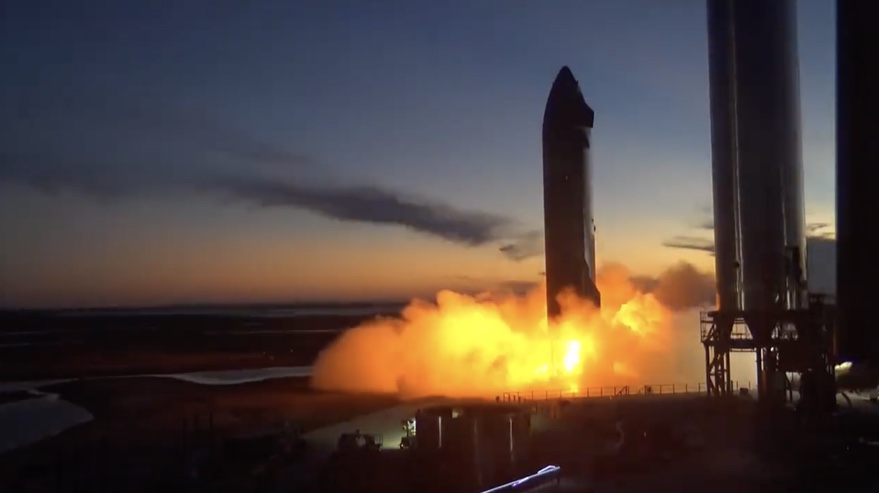Products You May Like
WASHINGTON — SpaceX performed a static-fire test of a Starship vehicle Oct. 21 as debate continues about an environmental assessment of the company’s proposed launch operations in Texas.
SpaceX performed two brief firings of a single Raptor engine mounted in a Starship vehicle called Ship 20 at its Boca Chica, Texas, test site. The tests were the first involving the vacuum variant of the engine, which has a much larger nozzle to accommodate the expanded plume when operating without significant atmospheric pressure.
First firing of a Raptor vacuum engine integrated onto a Starship pic.twitter.com/uCNAt8Kwzo
— SpaceX (@SpaceX) October 22, 2021
In a series of tweets, SpaceX Chief Executive Elon Musk explained that the high chamber pressure of the Raptor engine allows the company to test the vacuum version of the engine at sea level conditions without suffering significant separation of the exhaust from the nozzle.
Those tests and other work continue at Boca Chica as the Federal Aviation Administration performs its environmental assessment of orbital launch activities there, a requirement for issuing a launch license for the Starship/Super Heavy vehicle. The agency released for public comment Sept. 17 a draft programmatic environmental assessment (PEA) of those launch operations for public comment.
That public comment process included two virtual public hearings, held via Zoom, on Oct. 18 and 20. FAA officials provided an overview of the PEA and then accepted oral comments from the public. The agency is also accepting comments by mail and email through Nov. 1.
The public hearings showed sharp differences of opinion about SpaceX’s plans to conduct orbital launches from Boca Chica. Many attendees were strong advocates for the company and the proposed launch site, calling it critical to the nation’s future in space. They also played down the environmental impact, often comparing it to the launch sites at Cape Canaveral in Florida, which are embedded within a wildlife refuge.
“I stand with SpaceX and want them to have full approval to do as many launches as they need to make this system actually work,” said one participant, Aiden Girlya, at the Oct. 20 hearing, in a comment representative of many of the pro-SpaceX views aired at the meetings. “I do not believe they should be limited to a certain amount. They should be able to do as many launches as they need to because we have not seen any environmental impacts so far.”
Others emphasized the economic benefits of having SpaceX in the area, arguing they outweighed any environmental impacts. Jessica Tetreau-Kalifa, a Brownsville, Texas, city commissioner, said at the Oct. 18 hearing that SpaceX had turned the city from one of the poorest in the country to “one of the most sought-after ZIP codes” to live and work. “I don’t just ask you, I beg you to give them that permit.”
Opponents of SpaceX’s plans argued that the environmental impacts are already significant and that the draft PEA underestimates the even larger impacts of orbital launches. Bill Berg, a member of a nonprofit group called Save RGV that is opposed to a Boca Chica launch site, noted Oct. 20 that the number of nests of piping plovers, a threatened bird species, had dropped in the area from 41 three years ago to one this year.
Those opponents called on the FAA to require the development of an environmental impact statement (EIS), a more details environmental review, before issuing a launch license. Development of an EIS would take months or potentially years, delaying SpaceX’s plans.
“The stakes are simply too high not to invest in a thorough EIS,” said Sharon Wilcox, senior Texas representative for Defenders of Wildlife, a wildlife conservation nonprofit, at the Oct. 18 hearing.
The rhetoric got heated at times during the hearings, which lasted several hours each. Some critics of SpaceX accused the company of “environmental racism” by locating the site in an area with a large minority propulsion. Another attendee dismissed those claims as “wokeism.”
There was some nuance during the public comments, though. A few speakers, while generally supportive of SpaceX, wanted more information about elements of the company’s plans, such as a 250-megawatt power plant and transportation and storage of methane.
At the Oct. 20 hearing, Russell Sutton, a resident of Detroit, described himself as a “SpaceX fanboy” but also an environmentalist. “This PEA document is woefully inadequate in addressing many of the proposed expansions at Starbase,” SpaceX’s name for its Boca Chica facility. He called on SpaceX and the FAA to expedite development of an EIS, an approach that he argued would prevent legal challenges and delays.
Earlier in that hearing, Joshua Montgomery said he runs Wicked Broadband, a rural broadband provider based in Kansas. He said his company is a competitor to SpaceX’s Starlink, but he supported SpaceX’s plans for launching from Boca Chica, concluding that any environmental impacts can be mitigated.
“Despite the fact that this is going to impact my personal bottom line,” he said, “I would like to see the FAA move forward with the environmental studies as they’ve been provided and allow SpaceX to continue to launch from their Boca Chica facility.”
